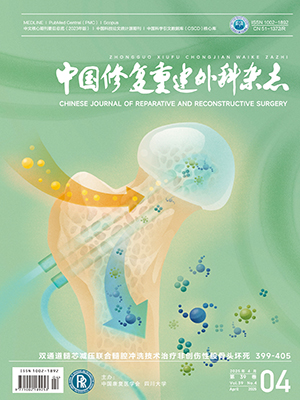Objective To evaluate tissue regeneration, body reaction, and biological safety of xenogeneous bladder acellular matrix (BAM) that can be used to repair rabbit bladder. Methods Porcine BAM was prepared through physical, chemical, and enzymatic methods, and the effects of acellularization and the structure were observed with HE staining and scanning electron microscope (SEM). Eighteen New Zealand white rabbits (weighing, 2.5-3.0 kg) undergoing partial cystectomy were randomly divided into 2 groups. After partial (about 30%) cystectomy, the porcine BAM was used to replace partial rabbit bladder in the experimental group (n=12), and the incision was directly sutured as control group (n=6). The survival condition of animals was observed after operation. At 15 days, 1, 2, 3, and 6 months after operation, the blood routine, renal function, and electrolyte were tested by collecting the blood samples. At 1, 2, 3, and 6 months after operation, maximum bladder capacity, bladder leak point pressure, and bladder compliance were measured through urodynamic studies. Then gross observation was performed for regeneration of bladder, and the specimens of the bladder were harvested for HE staining and immunohistochemical staining. The surrounding organs and local lymphoid tissues were harvested for gross observation and HE staining. Results Cell components were completely removed in the porcine BAM, showing three-dimensional porous structure under SEM. All the animals survived during the experiment. At 15 days after operation, white blood cell count increased, and then returned to normal level in 2 groups, showing no significant difference between 2 groups (P gt; 0.05). The tests of renal function and electrolyte suggested no significant difference between 2 groups (P gt; 0.05). The level of serum creatinine showed a tendency of increase, but it remained within normal range at 6 months after operation. The maximum bladder capacity and compliance in experimental group were significantly higher than those in control group at 3 and 6 months after operation (P lt; 0.05), but no significant difference in bladder leak point pressure at each time point between 2 groups (P gt; 0.05). The urothelial regeneration, smooth muscle regeneration, and blood vessel regeneration were seen by histological observation in 2 groups. In the 2 groups, chronic inflammatory cells infiltration could be observed at 1 month postoperatively, and then chronic inflammatory cells decreased significantly (P lt; 0.05), until complete disappearance. There was no significant difference in score of chronic inflammatory cell infiltration between 2 groups at 3 and 6 months after operation (P gt; 0.05). The α-smooth muscle actin expression was significantly increased with time passing in 2 groups (P lt; 0.05), and it was significantly higher in control group than in experimental group at each time point (P lt; 0.05). In addition, gross and HE staining observations showed no abnormalities in surrounding organs and local lymphoid tissues. Conclusion No immune rejection response occurs when porcine BAM is used for xenotransplantation. It is indicated that porcine BAM is relative safety for xenotransplantation.
Citation: ZHOU Liuhua,YANG Bin,WANG Pengji,XIA Jiadong,ZHANG Yifen,CHEN Yun,DAI Yutian. LOCAL AND SYSTEMIC SAFETY EVALUATION OF REGENERATED RABBIT BLADDER REPAIRED WITH XENOGENEOUS BLADDER ACELLULAR MATRIX. Chinese Journal of Reparative and Reconstructive Surgery, 2013, 27(8): 935-944. doi: 10.7507/1002-1892.20130205 Copy
Copyright © the editorial department of Chinese Journal of Reparative and Reconstructive Surgery of West China Medical Publisher. All rights reserved
-
Previous Article
EFFECT OF ALLOGENEIC CHONDROCYTES-CALCIUM ALGINATE GEL COMPOSITE UNDER INTERVENTION OF LOW INTENSIVE PULSED ULTRASOUND FOR REPAIRING RABBIT KNEE ARTICULAR CARTILAGE DEFECT GUOYang, MA Yong, DONG Rui, LIU Shanglun, TU Juan -
Next Article
PREPARATION AND BIO-EVALUATION OF TISSUE ENGINEERED SCAFFOLD BASED ON DECELLULARIZED WHOLE HEART EXTRACELLULAR MATRIX CHENWeizhen, DUAN Cuimi, LI Xia, SUN Hongyu, MOU Yongchao, SHU Yao CHEN Cheng, FENG Lanlan, ZHOU Jin, WANG Changyong




